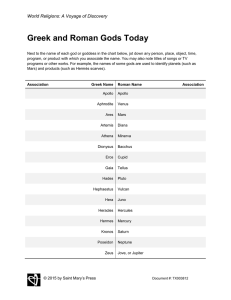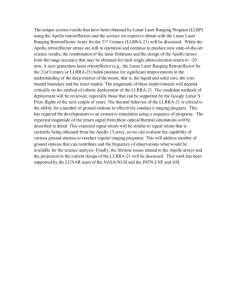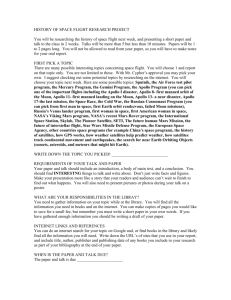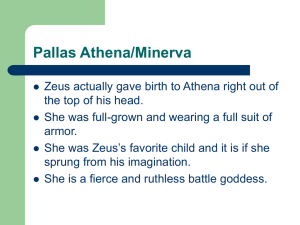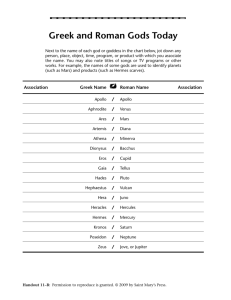APOLLO: millimeter lunar laser ranging
advertisement
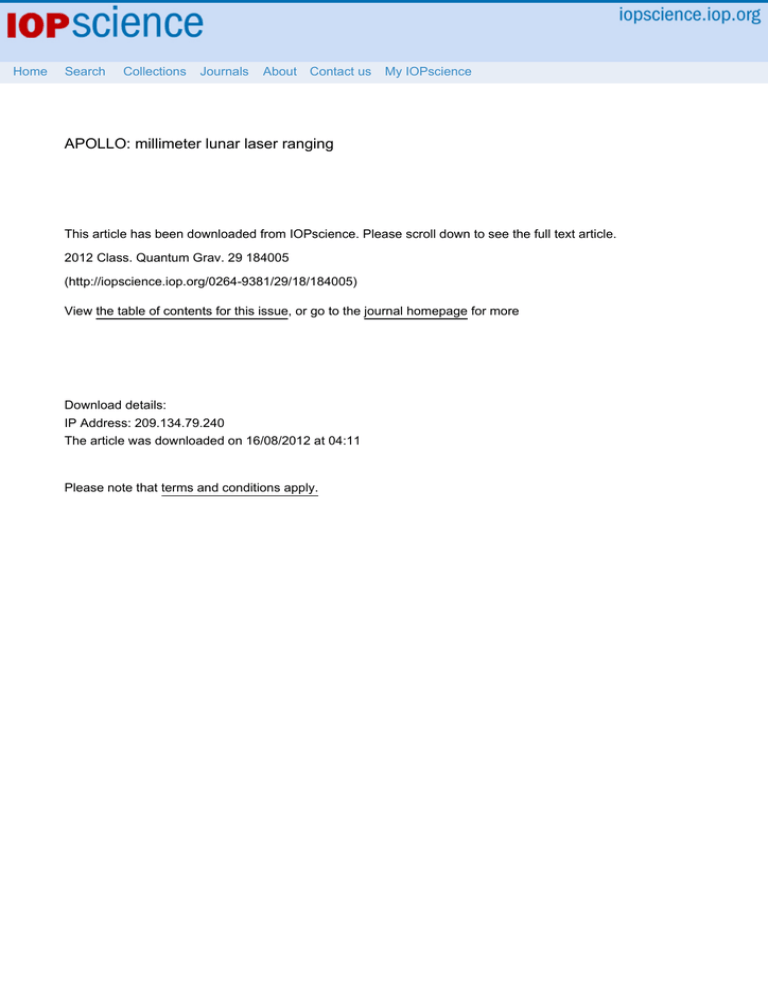
Home Search Collections Journals About Contact us My IOPscience APOLLO: millimeter lunar laser ranging This article has been downloaded from IOPscience. Please scroll down to see the full text article. 2012 Class. Quantum Grav. 29 184005 (http://iopscience.iop.org/0264-9381/29/18/184005) View the table of contents for this issue, or go to the journal homepage for more Download details: IP Address: 209.134.79.240 The article was downloaded on 16/08/2012 at 04:11 Please note that terms and conditions apply. IOP PUBLISHING CLASSICAL AND QUANTUM GRAVITY Class. Quantum Grav. 29 (2012) 184005 (11pp) doi:10.1088/0264-9381/29/18/184005 APOLLO: millimeter lunar laser ranging T W Murphy Jr 1 , E G Adelberger 2 , J B R Battat 3 , C D Hoyle 4 , N H Johnson 1 , R J McMillan 5 , C W Stubbs 6 and H E Swanson 2 1 Center for Astrophysics and Space Sciences, University of California, San Diego, 9500 Gilman Drive, La Jolla, CA 92093-0424, USA 2 Center for Experimental Nuclear Physics and Astrophysics, Box 354290, University of Washington, Seattle, WA 98195-4290, USA 3 Department of Physics, Bryn Mawr College, 101 N Merion Avenue, Bryn Mawr, PA 19010, USA 4 Department of Physics and Astronomy, Humboldt State University, One Harpst St, Arcata, CA 95521-8299, USA 5 Apache Point Observatory, 2001 Apache Point Rd, Sunspot, NM 88349-0059, USA 6 Department of Physics, Harvard University, 17 Oxford St, Cambridge, MA 02318, USA E-mail: tmurphy@physics.ucsd.edu Received 8 February 2012, in final form 19 April 2012 Published 15 August 2012 Online at stacks.iop.org/CQG/29/184005 Abstract Lunar laser ranging (LLR) has for decades stood at the forefront of tests of gravitational physics, including tests of the equivalence principle (EP). Current LLR results on the EP achieve a sensitivity of a/a ≈ 10−13 based on few-centimeter data/model fidelity. A recent push in LLR, called APOLLO (the Apache Point Observatory Lunar Laser-ranging Operation) produces millimeter-quality data. This paper demonstrates the few-millimeter range precision achieved by APOLLO, leading to an expectation that LLR will be able to extend EP sensitivity by an order-of-magnitude to a/a ∼ 10−14 , once modeling efforts improve to this level. PACS numbers: 95.30.Sf, 04.80.−y, 04.80.Cc (Some figures may appear in colour only in the online journal) 1. Introduction By measuring the Earth–Moon distance to high precision, we may test a variety of aspects of gravity, including the weak equivalence principle (WEP), the strong equivalence principle (SEP), the time-rate-of-change of the gravitational constant (Ġ), gravitomagnetism, geodetic precession, the inverse-square law, preferred frames, and other aspects of relativistic gravity [1–8]. Relativistic effects on the Earth–Moon system—as expressed in the solar system barycenter (SSB) frame—tend to have amplitudes in the few-meter range. As such, lunar laser 0264-9381/12/184005+11$33.00 © 2012 IOP Publishing Ltd Printed in the UK & the USA 1 Class. Quantum Grav. 29 (2012) 184005 T W Murphy Jr et al ranging (LLR) data at few-centimeter accuracy over the past several decades has permitted tests of relativistic gravity to about one part in a thousand. Specifically, LLR tests of the WEP are currently at the level of a/a ∼ 10−13 . Earth’s gravitational self-energy amounts to ∼ 5 × 10−10 of its total mass-energy budget, implying that the SEP is currently tested to about 2 × 10−4 . A more careful assessment results in a constraint on |ηSEP | < 4.5 × 10−4 [1]. See the articles by Williams et al [9] and by Müller et al [10] in this same issue for a more thorough treatment of LLR’s capability with respect to the equivalence principle. Also see the Wagner et al article on laboratory tests of the WEP that can be used in conjunction with LLR tests of the EP to differentiate between WEP and SEP violation [11]. The relative imprecision to which we have tested relativistic gravity to date, combined with a host of puzzles in physics and cosmology, establishes an imperative to subject gravity to the most stringent tests possible. It was with this in mind that we initiated a new campaign in LLR called APOLLO (the Apache Point Lunar Laser-ranging Operation [12]), the goal of which is to achieve millimeter precision so that each of the leading tests performed by LLR can be extended by an order of magnitude. APOLLO shares time on the competitively-scheduled 3.5 m telescope at the Apache Point Observatory, located atop a 2.9 km mountain in southern New Mexico. Battat et al (2009) provided an early assessment of APOLLO data quality [13]. In this paper, we demonstrate routine achievement of ∼1 mm range precision, and briefly note the prospects for improved tests of gravity. By way of introduction, APOLLO’s exceptional return rate and associated instrumentation allow us to explore aspects of lunar ranging that are off-limits to other operations. The following points highlight APOLLO’s various advantages. • Except in the worst observing conditions, APOLLO rapidly acquires signal on 4–5 reflectors in sequence, and generally can repeat the sequence within the course of an hour-long observing session. We can therefore ascertain the lunar orientation and tidal distortion that are needed to convert surface ranges into a measure of the lunar center-ofmass position—itself critical for testing gravity. • APOLLO re-discovered the lost Lunokhod 1 reflector, whose relative proximity to the lunar limb makes it highly sensitive to lunar orientation. In March 2010, the Lunar Reconnaissance Orbiter (LRO) identified the rover in a high-resolution image, providing much more accurate coordinates (5 km away from our previous search point). We quickly acquired the Lunokhod 1 reflector—finding it to be in good condition—and determined its position on the Moon to few-centimeter precision [14]. The reflector is now routinely incorporated into the ranging sequence. • APOLLO’s high signal rate permits real-time signal optimization. We can therefore be confident that the observed rate is a reliable measure of total system performance. This in turn has led to an understanding that the reflectors have degraded in time, and that an additional signal loss is experienced around full moon [15]. • APOLLO installed a superconducting gravimeter at the observatory in March 2009 and has access to a nearby high-precision GPS antenna that is part of the NSF-funded EarthScope effort. The two instruments constrain the dynamic solid-earth effects (tides and ocean and atmospheric loading) needed to relate the observatory position to the Earth’s center of mass. In addition, the gravimeter strengthens the EarthScope geodesy effort, and contributes data to the Global Geodynamics Project. • Unlike other LLR facilities, APOLLO can range at full moon—although at a reduced signal rate as indicated above. By sampling the lunar cycle more uniformly than was previously possible, we substantially improve the orthogonality of extracted signals occurring at 2 Class. Quantum Grav. 29 (2012) 184005 T W Murphy Jr et al Figure 1. APOLLO performance history through the beginning of 2011. The Apollo 15 reflector dominates the dataset, for a variety of reasons explained in the text, although its fractional contribution trends downward. The discovery of Lunokhod 1 is apparent, as is a seasonal lull brought about by summer monsoons and associated observatory maintenance shutdown. different periods [16]. This is especially important for testing the equivalence principle, where the violating signal is maximum at full moon. • APOLLO’s high signal rate allows us to explore systematic errors that were not possible previously. For example, the temporal shape of the return is well-enough defined to determine angular offsets of the reflectors, and to look for any signal centroid offset from the physical centroid of the reflector due to non-uniform response across the reflector array. Also, the ability to rapidly cycle through the reflectors—making 2–3 rounds in a typical 1 h session—provides a measure of instrument stability and a check on our estimated uncertainties. In this paper, we focus attention on demonstrating millimeter ranging performance. 2. APOLLO performance 2.1. Observations APOLLO observations began in 2006. Figure 1 shows the steady accumulation of measurements. The bulk of the data comes from the Apollo arrays, while the Lunokhods also contribute (note the appearance of Lunokhod 1 in 2010). The Apollo 15 reflector is the easiest reflector to acquire owing to the fact that it is three times larger than the first two Apollo arrays, and also is located next to distinct topography. The Lunokhod reflectors do not perform as well as the Apollo arrays in lunar daytime. Even in the dark, Lunokhod 2 delivers a signal about five times lower than the identicallydesigned Lunokhod 1 reflector, and 10 times lower than Apollo 15. The superior signal strength of Apollo 15 has resulted in a dominant representation in the data record. As the descending black line in figure 1 shows, Apollo 15 likewise dominated APOLLO ranges in the early years, but has steadily decreased since. Even so, Apollo 15 will continue to receive more attention from APOLLO than will the other reflectors. Easiest initial acquisition is one reason. If the signal is weak due to adverse observing conditions, we are likely to make repeated measurements on Apollo 15 rather than spending precious telescope time failing 3 Class. Quantum Grav. 29 (2012) 184005 T W Murphy Jr et al Table 1. Record rates on the five reflectors, in photons per minute for the OCA and APOLLO LLR stations. The ratio of photon rates is also shown, as is the corresponding APOLLO photon rate in photons per shot. APOLLO results are all based on 5000 shot runs lasting 250 s. Reflector OCA phot/min APOLLO phot/min Ratio APOLLO phot/shot Apollo 11 Lunokhod 1 Apollo 14 Apollo 15 Lunokhod 2 17 – 26 46 6 1148 497 1825 3775 312 69 – 69 67 54 0.96 0.41 1.52 3.15 0.26 to raise weaker reflectors. Also, we make a point of ending our (typically 1 h) sessions on Apollo 15 in order to maximize our baseline for contributing to Earth orientation analyses. APOLLO’s signal performance far exceeds that of previous efforts, owing to the large telescope aperture, good atmospheric seeing, and an array detector. We have surpassed the previous record return rates—all held by the Observatiore de la Côta d’Azur (OCA)—by a factor of ∼70 for the three Apollo reflectors, and by a factor of ∼50 for the Lunokhod 2 array. Table 1 details APOLLO’s record rates, all based on 5000-shot (250 s) runs. A remarkable consistency is seen in the ratio of APOLLO to OCA records for the three Apollo reflectors. The Lunokhod 2 performance falls short of this ratio, perhaps consistent with its more rapid degradation [15]. The greater photon rate achieved by APOLLO translates to a better statistical determination of the reflector range. It is via photon number that APOLLO is able to reach the millimeter level. Tilt of the reflector array due to varying lunar libration contributes the largest uncertainty to any individual photon, typically between σ ∼15–50 mm. Thus √ hundreds or thousands of photons are required to reduce the centroid uncertainty to σ / N ∼ 1 mm. Figure 2 shows an example return from APOLLO, demonstrating typical timing performance, as well as our understanding of the temporal shapes of the returns from both the local corner cube and the lunar array. Because the lunar array is tilted differently each night by lunar libration, the temporal response includes a trapezoidal contribution to timing that can be quite broad—up to 1 ns full-width at half-maximum (FWHM). By the end of its first year of steady operation, APOLLO had realized its goal of 1 mm range precision on a routine basis. Figure 3 shows the range precision per reflector over about five years. For sessions (nights) in which we obtained more than one range measurement to a reflector, the combined uncertainty is plotted for that reflector. Median uncertainties per reflector tend to be 2–3 mm per night. Combining all measurements within a night yields a median nightly uncertainty around 1.4 mm. Even the poorest measurements in figure 3 are better than typical range uncertainties prior to APOLLO. As alluded to previously, Apollo 15 is a preferred LLR target, and has dominated the range data to date. Figure 4 shows the distribution of ranges among the reflectors, with Apollo 15 (reflector 3) dominating for all stations. The McDonald Laser Ranging System (MLRS) dwells on Apollo 15 83% of the time, and the corresponding number is 80% for OCA. For APOLLO, Apollo 15 accounts for about 50% of range measurements overall, down to 43% more recently. More fundamental than measurement count by reflector is the number of reflectors observed within a short period. Determining the lunar orientation—which is important for converting surface ranges into center-of-mass position—requires observation of at least three reflectors. As seen in figure 5, APOLLO acquires ranges to three or more reflectors on 62% of the operating nights, and 78% in recent times. Compare this to MLRS: 7% overall and 3% since 2000; and OCA: 24% overall and 18% since 2000. So in addition to having superior 4 Class. Quantum Grav. 29 (2012) 184005 T W Murphy Jr et al Figure 2. Example APOLLO data on Apollo 15 from 2010 March 23. At left is the return from the fiducial corner cube—mounted at the telescope exit aperture—establishing the pulse departure time and end-to-end timing performance. At right is the lunar return, together with the trapezoidal reflector response curve (red: here nearly rectangular) induced by the rectangular array tilted by lunar libration. Also shown is the (blue) lunar fit, constructed as a convolution of the fiducial fit curve with the trapezoid. For each, the full-width at half-maximum and standard deviation (FWHM and σ ), as well as the number of contributing photons are given for the points within ±0.5 ns of the center √ for the fiducial return, and within ±1.0 ns of the center for the lunar return. The value, σr = σ / N is the statistical centroid uncertainty, and σmm is the expression of this same quantity as one-way range uncertainty. Data are binned to 100 ps for a smoother display, but the fits are based on intrinsic 25 ps binning. Figure 3. Combined nightly uncertainty for each reflector on each night of ranging. A number of points lie below the dashed line at 1 mm. The median uncertainties for the A11, L1, A14, A15 and L2 reflectors are 2.4, 2.7, 2.4, 1.8 and 3.3 mm, respectively. Combining all reflectors within a night yields a median uncertainty of 1.4 mm per night. 5 Class. Quantum Grav. 29 (2012) 184005 T W Murphy Jr et al Figure 4. Distribution of normal point measurements for the three primary LLR stations. Reflectors are numbered in order of appearance: A11, L1, A14, A15, L2. Apollo 15 dominates all data sets, but less so for APOLLO. The data are broken into ‘recent’ (darker) and overall statistics, with the dividing line at the year 2000.0 for the older stations, and 2010.0 for APOLLO. Recently, APOLLO spends comparable time on A11, L1 and A14, and about double this amount on A15. Figure 5. Frequency of observing differing numbers of reflectors per night for the three primary LLR stations. Shading carries the same meaning as in figure 4. Total nights observed are given for each station’s total historical operation, and for a more recent period. At least three reflectors are required to determine lunar orientation, which has been the mode for APOLLO. More recently, following the discovery of Lunokhod 1, APOLLO’s mode has increased to four. range uncertainty, the reflector sampling for APOLLO offers a substantial improvement for determining lunar orientation. Recently, four reflectors are most commonly acquired, and we measure five reflectors in a session as often as we do three. 2.2. APOLLO error budget Thus far, discussion has centered on random uncertainty of APOLLO data points. Figure 2 demonstrates a typical end-result of 135 ps (1σ ) per photon, based on the fiducial corner cube return. This number has at times been as low as about 110 ps. Because we do not have the means to evaluate each contribution in the error budget (laser pulse width, for instance), and laboratory measurements tend to be quieter than on-site measurements in the presence of laser fire, for instance, we cannot offer a precise breakdown of the terms contributing to the random uncertainty. But such a budget would look something like 10 ps from the clock, 30 ps from timing electronics, 70 ps from the laser pulse width, 60 ps from spatial illumination delay in 6 Class. Quantum Grav. 29 (2012) 184005 T W Murphy Jr et al the APD, and 90 ps from the intrinsic APD response. We are presently working on reducing the last term. The important result, however, is that we can measure the combined effect to be in the neighborhood of 130 ps. Systematic errors are naturally much more difficult to assess. The APOLLO measurement scheme strives to be as differential as possible, employing the same optical path, detector, and timing electronics for the fiducial corner cube return and the lunar return. Possible contributions to systematic error would be: (1) local corner cube placement—attached to the secondary mirror glass via break-away mount; (2) frequency offset of the GPS-disciplined clock; and (3) electromagnetic noise from the laser fire disrupting timing accuracy for the fiducial—possibly in a biased way. The last mode could disrupt the differential nature of the measurement. At present, we do not believe any of these to cause major problems, but lack a qualified yardstick against which to be certain, given the current state of modeling uncertainty. The coherence of measurements across hour-long sessions—as discussed below—offers some reassurance against laser noise disruption: our measurements are not bouncing around over these timescales as the laser evolves its thermal state. For the clock, an uncharacteristically large GPS timing excursion might be 20 ns over the course of an hour, representing a frequency offset of ∼ 5 × 10−12 , corresponding to 2 mm of measurement offset. But this should not be systematic from one night to the next. The clock steering algorithm employs a characteristic time of 2100 s, so that shorter-term frequency offsets arising from the GPS scheme are suppressed. On the topic of clock disciplining, we also experience somewhat crude clock steps in the steering algorithm, corresponding to 35 ps offsets in the round-trip travel time. Since this error is uniformly distributed (clock stability is better than the step size, √ resulting in infrequent transitions between two closest steps), the steps contribute a 35/ 12 ∼ 10 ps root-meansquare error that is actually random in nature, rather than systematic. We currently add 10 ps in quadrature to exported normal point uncertainty estimates, although we store full-rate data on clock steps at the oscillator update period of 10 s, and therefore have the option to correct the normal point value according to the surrounding clock step history. 3. Checking against a model As we have demonstrated here and in Battat et al [13], internal checks suggest that we understand our system and achieve millimeter-level ranges on a routine basis. So far, residuals produced by subtracting model results from APOLLO data—where the models are fit to the observations—have turned in weighted root-mean-square (RMS) deviations on the scale of 20–40 mm across four independent models (one at the Jet Propulsion Laboratory; the Planetary Ephemeris Program maintained at Harvard University; one at the University of Hannover, Germany; and INPOP in Paris, France). Thus current science deliverables resulting from APOLLO data are not substantively improved over the previous state-of-the-art. Yet we firmly believe that data of higher quality will point the way to the model improvements and additions that are necessary in order to realize the full potential of APOLLO data. One technique we can employ to investigate the fidelity of APOLLO data in reference to the model is to restrict attention to short time periods, where many potential systematic (unmodeled) effects are common-mode over the ∼1 hr observations. Compared against any of the models we have seen, a similar phenomenon emerges: residuals cluster by reflector in accordance with their estimated error bars. In other words, All Apollo 11 residuals within the night are self-consistent within estimated uncertainties, but may be distinctly separated from the cluster of Apollo 14 residuals, etc. Figure 6 demonstrates a few examples of this behavior. 7 Class. Quantum Grav. 29 (2012) 184005 T W Murphy Jr et al Figure 6. Example observed-minus-calculated (O−C) residuals from the Hannover LLR model. The dates, 2010 April 5 (left), and 2010 October 16 (right), are chosen to emphasize reflector spread. The symbol shapes and colors follow that of figure 3. Residuals separate into clusters according to reflector, the scatter within each cluster being consistent with the estimated error bars for that reflector. The reflector-specific spread seen in figure 6 indicates that the model is not perfectly describing the orientation of the Moon. An offset in orientation brings one reflector closer while pushing another farther away. We can perform a solid-body rotation of the Moon in order to minimize the uncertainty-weighted offsets in a least-squares sense, and then ask if such ad hoc adjustments—not based on any dynamical model—can tell us anything about data quality. Using the LLR model having the very best lunar orientation performance (the model at the Jet Propulsion Laboratory), four cases are investigated involving combinations of two data analysis options. The first option is whether APOLLO data is fit together with all historical LLR data or by itself. The second option is whether or not a down-weighting scheme is applied to APOLLO data in order to yield an overall reduced χ 2 around 1.0 for APOLLO residuals. In this case, it is found that a 15 mm term must be added in quadrature to all APOLLO uncertainty estimates, which could imply grossly underestimated uncertainties on the part of APOLLO, unmodeled systematics, or some combination of both. Figure 7 explores all four combinations, plotting the angular offset in longitude that must be applied to the Moon in order to minimize the reflector-to-reflector spread among residuals. A similar plot can be made for latitude adjustments, not shown here. Note that such orientation adjustments only reduce the spread among reflectors, but may leave the group at some significant offset from zero. Thus the adjustment may not significantly reduce the RMS of the overall residuals, and therefore does not substantially lower the χ 2 value discussed in the previous paragraph. The error bars shown in figure 7 are based on the intrinsic, estimated uncertainties from APOLLO rather than the inflated uncertainties that were used in some of the model fits that produced the residuals (left side of figure). In each frame of figure 7, the reduced χr value is given for the null hypothesis—that the distribution of points about zero is consistent with uncertainty estimates, meaning that no adjustment to libration longitude is preferred by the data. We see evident structure at a roughly three-year period in the top-left frame, corresponding to down-weighted APOLLO data fit together with historical LLR data. A 2.9 year resonant 8 Class. Quantum Grav. 29 (2012) 184005 T W Murphy Jr et al Figure 7. Determination of lunar orientation under different treatments of APOLLO data. One nanoradian is 1.7 mm of lateral motion at the lunar surface. Each data point represents one of 106 nights in which we obtained range measurements to at least three reflectors, providing an independent probe of lunar orientation. The degree to which the model fits APOLLO data depends on whether APOLLO’s estimated uncertainties are inflated by a 15 mm root-sum-square term (left panels) or not (right panels), and whether APOLLO data are fitted alone (bottom panels) or in conjunction with all historical LLR data (top panels). The fit at upper left shows a clear libration signature with a ∼3 yr period. Treating APOLLO data at full weight nearly eliminates this signal (upper right)—as does fitting to APOLLO data alone (lower panels). Error bars on the orientation are derived from the original estimated uncertainties of APOLLO data points, and do not reflect inflated uncertainties used in the model. The reduced χ values indicate that in some cases the model is capable of reproducing APOLLO data within a factor of 1.8 of the estimated uncertainties. period in the longitude librations is likely responsible for this signature. Hints of this structure persist until the lower-right frame, in which APOLLO data is fit alone at full weight. In this case, the reduced chi value, χr = 1.8, may indicate that APOLLO uncertainties are underestimated by a factor of 1.8. If this is the case, the median nightly uncertainty would become 2.5 mm instead of 1.4 mm. In any case, the APOLLO data appear to be saying something real about lunar orientation, and the model has the necessary dynamics to tame the variation as APOLLO data is given greater weight. It is worth noting that the RMS of OCA post-fit residuals after 1995 increases from 16.55 mm to 17.49 mm when fitting APOLLO data at full-weight (moving from upper-left to upper-right panels in figure 7). While this is a statistically significant change (5.7 mm in quadrature, or 0.34 × σOCA ), the impact is not dramatic. An interesting point is obtained by comparing the bottom panels in figure 7 corresponding to APOLLO-only model fits. Down-weighted APOLLO data points essentially all have 15 mm uncertainties. Without the ability to distinguish which data points are more precise, the lunar orientation is not as well matched to the data set. This further suggests that APOLLO’s 9 Class. Quantum Grav. 29 (2012) 184005 T W Murphy Jr et al estimated uncertainties are providing real information/value, and that they are significantly better than 15 mm. In general terms, the fact that a dynamical model based on our best-known physical attributes of the lunar interior is capable of matching the orientation information inherent in five years of APOLLO’s multiple-reflector data is very encouraging (lower-right panel of figure 7). Inadequate fits to the orientation appear to emerge when fitting to the full LLR dataset over four decades. This suggests that subtle, long period influences on lunar orientation have yet to be properly understood and modeled. But high-quality data is the first step toward improving the model. 4. Conclusion In effect, we can demonstrate that APOLLO data has short-term precision at the few-millimeter level. We cannot yet be sure if this translates into millimeter accuracy over longer periods without an adequate reference (model) against which to compare. The high signal rate delivered by APOLLO has translated into routine observations of three or more reflectors during the short observing sessions, offering a powerful tool for determining lunar orientation. Not only does this provide some measure of APOLLO performance, but we may now determine the track of the Moon’s center of mass to higher precision than ever before. Thus the orientation fix alone is enough to improve tests of gravitational physics such as the equivalence principle. Besides the orientation improvements, we also expect the high-precision range data to have a directly beneficial impact on tests of gravitation. Ultimately, millimeter-quality data may be able to improve our constraints on gravitational physics by an order-of-magnitude—given that the present limits are based on ∼2 cm post-fit residual performance. In the meantime, our focus must shift to model improvements that can take full advantage of millimeter data. It is only via such a campaign that we will truly be able to judge the longer-term quality embodied in APOLLO data and reap the science rewards within. Acknowledgments This work has been jointly funded by the National Science Foundation (NSF: PHY0602507; PHY1068879) and by NASA (NNX-07AH04G), and some of this analysis was supported by the NASA Lunar Science Institute as part of the LUNAR consortium (NNA09DB30A). We thank Jim Williams and Dale Boggs at the Jet Propulsion Laboratory, and Jürgen Müller and Franz Hofmann of the University of Hannover for the model residuals on which some of the figures are based. This work is based on observations obtained with the Apache Point Observatory 3.5-meter telescope, which is owned and operated by the Astrophysical Research Consortium. References [1] Williams J G, Turyshev S G and Boggs D H 2009 Lunar laser ranging tests of the equivalence principle with the Earth and Moon Mod. Phys. Lett. A 24 1129–75 (arXiv:gr-qc/0507083) [2] Williams J G, Turyshev S G and Boggs D H 2004 Progress in lunar laser ranging tests of relativistic gravity Phys. Rev. Lett. 93 261101 (arXiv:gr-qc/0411113) [3] Müller J and Biskupek L 2007 Variations of the gravitational constant from lunar laser ranging data Class. Quantum Grav. 24 4533–8 [4] Murphy T W, Nordtvedt K and Turyshev S G 2007 Gravitomagnetic influence on gyroscopes and on the lunar orbit Phys. Rev. Lett. 98 071102 (arXiv:gr-qc/0702028) [5] Murphy T W 2009 Lunar ranging, gravitomagnetism and APOLLO Space Sci. Rev. 148 217–23 10 Class. Quantum Grav. 29 (2012) 184005 T W Murphy Jr et al [6] Soffel M, Klioner S, Müller J and Biskupek L 2008 Gravitomagnetism and lunar laser ranging Phys. Rev. D 78 024033 [7] Adelberger E G, Heckel B R and Nelson A E 2003 Tests of the gravitational inverse-square law Annu. Rev. Nucl. Part. Sci. 53 77–121 [8] Müller J, Nordtvedt K and Vokrouhlicky D 1996 Improved constraint on the α1 PPN parameter from lunar motion Phys. Rev. D 54 R5927–30 [9] Williams J G, Turyshev S G and Boggs D 2012 Lunar laser ranging tests of the equivalence principle Class. Quantum Grav. 29 184004 [10] Müller J, Hoffman F and Biskupek L 2012 Testing various facets of the equivalence principle using lunar laser ranging Class. Quantum Grav. 29 184006 [11] Wagner T A, Schlamminger S, Gundlach J H and Adelberger E G 2012 Torsion-balance tests of the weak equivalence principle Class. Quantum Grav. 29 184002 [12] Murphy T W et al 2008 The apache point observatory lunar laser-ranging operation: instrument description and first detections Publ. Astron. Soc. Pac. 120 20–37 (arXiv:0710.0890) [13] Battat J B R et al 2009 The Apache Point Observatory lunar laser-ranging operation (APOLLO): two years of millimeter-precision measurements of the Earth–Moon range Publ. Astron. Soc. Pac. 121 29–40 [14] Murphy T W, Adelberger E G, Battat J B R, Hoyle C D, Johnson N H, McMillan R J, Michelsen E L, Stubbs C W and Swanson H E 2011 Laser ranging to the lost Lunokhod 1 reflector Icarus 211 1103–8 (arXiv:1009.5720) [15] Murphy T W, Adelberger E G, Battat J B R, Hoyle C D, McMillan R J, Michelsen E L, Samad R L, Stubbs C W and Swanson H E 2010 Long-term degradation of optical devices on the Moon Icarus 208 31–5 (arXiv:1003.0713) [16] Nordtvedt K 1998 Optimizing the observation schedule for tests of gravity in lunar laser ranging and similar experiments Class. Quantum Grav. 15 3363 11

